Smartphone-Based Assessment of Bicycle Pavement Conditions Using the Bicycle Road Roughness Index and Faulting Impact Index for Sustainable Urban Mobility
Abstract
1. Introduction
2. Methodology
2.1. Study Area
2.2. Experimental Setup and Data Collection
2.3. Development and Calculation of Surface BRI and FII
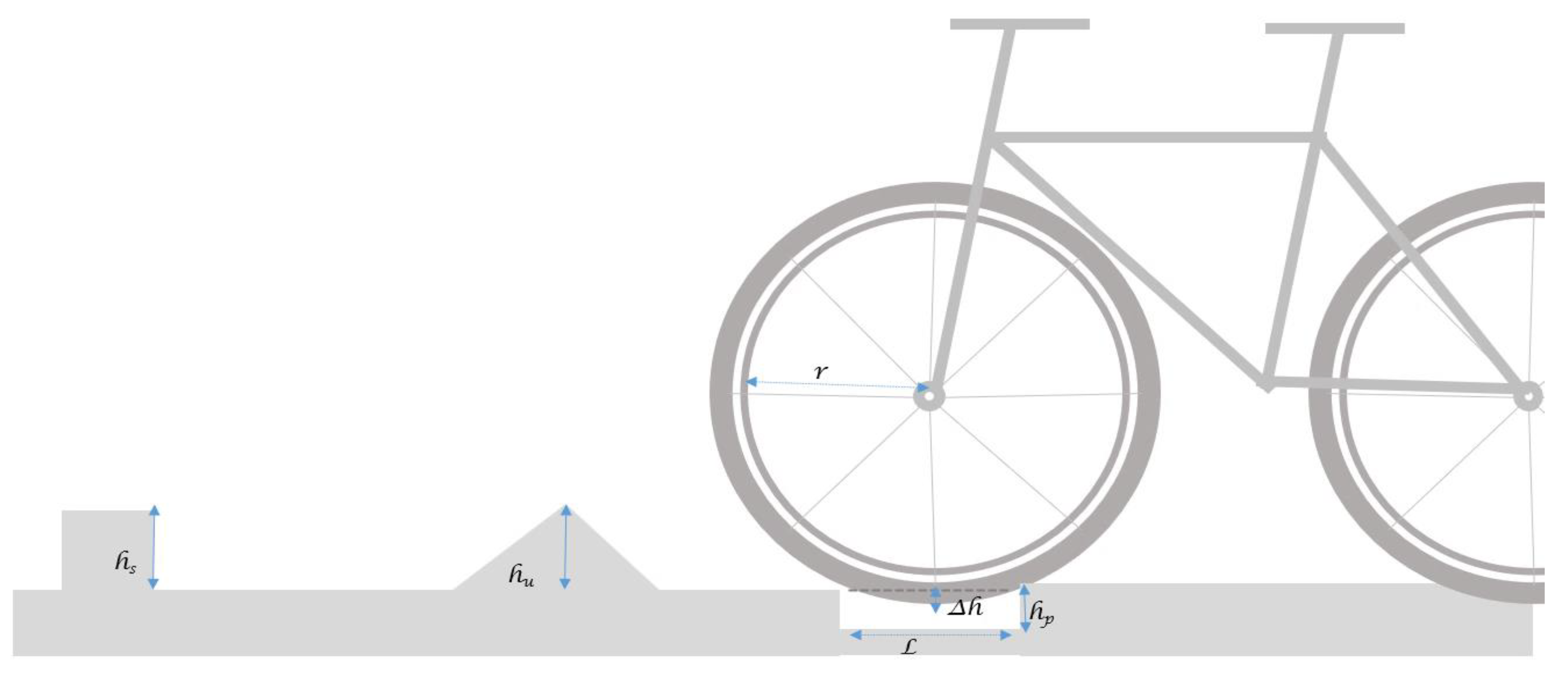
2.4. User Evaluation of Rideability Using Surface Roughness and Risk Assessment
2.5. Pilot Test Assessment Using Measurement Equipment
3. Results
3.1. Panel-Based Surface Roughness Assessment Results
3.2. Risk Classification Based on Panel Perception of Risk Assessment
3.3. Bicycle Road Pilot Test for Verification
3.4. Criteria for Risk Assessment in Bicycle Roads
4. Discussion
5. Conclusions
Author Contributions
Funding
Institutional Review Board Statement
Informed Consent Statement
Data Availability Statement
Acknowledgments
Conflicts of Interest
References
- Smith, K.; Ram, P. Measures and Specifying Pavement Smoothness; FHWA: Washington, DC, USA, 2016. [Google Scholar]
- Lah, T.J.; Lee, H.; Cho, Y. The Four Major Rivers Restoration Project of South Korea: An Assessment of Its Process, Program, and Political Dimensions. J. Environ. Dev. 2015, 24, 375–394. [Google Scholar] [CrossRef]
- Fishman, E.; Washington, S.; Haworth, N. Bike Share: A Synthesis of the Literature. Transp. Rev. 2013, 33, 148–165. [Google Scholar] [CrossRef]
- Chang, C.L.; He, S.; Qian, J.Z.; Mao, L.J. Pavement flatness test technology summary. J. Highw. Transp. Res. Dev. 2006, 4, 7. [Google Scholar]
- Ahmed, T.; Pirdavani, A.; Sitohang, I.F.; Wets, G.; Janssens, D. Assessment methods for bicycle environment safety and comfort: A scoping review. Saf. Future Transp. Res. 2025, 5, 100457. [Google Scholar] [CrossRef]
- Ahmed, T.; Pirdavani, A.; Janssens, D.; Wets, G. Utilizing Intelligent Portable Bicycle Lights to Assess Urban Bicycle Infrastructure Surfaces. Sustainability 2023, 15, 4495. [Google Scholar] [CrossRef]
- Gao, J.; Sha, A.; Huang, Y.; Hu, L.; Tong, Z.; Jiang, W. Evaluating the Cycling Comfort on Urban Roads Based on Cyclists’ Perception of Vibration. J. Clean. Prod. 2018, 199, 103–113. [Google Scholar] [CrossRef]
- Zang, K.; Shen, J.; Huang, H.; Wan, M.; Shi, J. Assessing and Mapping of Road Surface Roughness Based on GPS and Accelerometer Sensors on Bicycle-Mounted Smartphones. Sensors 2018, 18, 914. [Google Scholar] [CrossRef] [PubMed]
- Kim, K.; Jo, S.H.; Ahn, J.; Kim, N. A Study on the Evaluation Criteria of Pavement Condition Using Investigation Equipment of Bicycle Road. KSCE J. Civ. Environ. Eng. Res. 2016, 36, 1125–1131. [Google Scholar] [CrossRef]
- Acerra, E.M.; Shoman, M.; Imine, H.; Brasile, C.; Lantieri, C.; Vignali, V. The Visual Behaviour of the Cyclist: Comparison between Simulated and Real Scenarios. Infrastructures 2023, 8, 92. [Google Scholar] [CrossRef]
- Setiawan, E.; Nurdin, H. Road Quality Assessment Using International Roughness Index Method and Accelerometer on Android. J. Inf. Technol. Intell. Syst. 2019, 10, 62–73. [Google Scholar] [CrossRef]
- Aranda Britez, D.A.; Tapia Córdoba, A.; Johnson, P.; Pacheco Viana, E.E.; Millán Gata, P. Improving the Calibration of Low-Cost Sensors Using Data Assimilation. Sensors 2024, 24, 7846. [Google Scholar] [CrossRef] [PubMed]
- Lee, J. A Study on the Development of a Bicycle Road Surface Roughness Evaluation Using Smartphone Sensors. Ph.D. Thesis, Hongik University, Seoul, Republic of Korea, 2023. [Google Scholar] [CrossRef]
- Douangphachanh, V.; Oneyama, H. Using smartphones to estimate road pavement condition. In Proceedings of the International Symposium for Next Generation Infrastructure, Wollongong, Australia, 1–4 October 2013. [Google Scholar]
- Karantonis, D.M.; Narayanan, M.R.; Mathie, M.; Lovell, N.H.; Celler, B.G. Implementation of a Real-Time Human Movement Classifier Using a Triaxial Accelerometer for Ambulatory Monitoring. IEEE Trans. Inf. Technol. Biomed. 2006, 10, 156–167. [Google Scholar] [CrossRef] [PubMed]
- Jeong, K.; Lee, J.; Lee, D. Construction and Utilization of Big Data for Personal Mobility Using Smart Devices; Korea Transport Institute: Sejong, Republic of Korea, 2021; pp. 83–139. [Google Scholar]
- Tamagusko, T.; Gomes Correia, M.; Rita, L.; Bostan, T.-C.; Peliteiro, M.; Martins, R.; Santos, L.; Ferreira, A. Data-Driven Approach for Urban Micromobility Enhancement through Safety Mapping and Intelligent Route Planning. Smart Cities 2023, 6, 2035–2056. [Google Scholar] [CrossRef]
- Ministry of the Interior and Safety; Ministry of Land, Infrastructure and Transport. Guidelines for Installation and Management of Bicycle Facilities; Ministry of the Interior and Safety: Sejong, Republic of Korea, 2022; Available online: https://www.scribd.com/document/686733214 (accessed on 31 May 2025). (In Korean)
- Lee, S.; Bae, Y.; Kwon, Y.-C.; Kim, J.-H. A Study for Pavement Smoothness Index Reflecting Urban Road Characteristics. Seoul Stud. 2015, 16, 129–145. [Google Scholar]
- Siddiqui, O.; DiBiase, S.; Hoang, R.; Nguyen, B.; Khan, O.; Famiglietti, N. Evaluating the Accuracy and Reliability of Bicycle GPS Devices. SAE Int. J. Adv. Curr. Prac. Mobil. 2021, 3, 3093–3114. [Google Scholar] [CrossRef]
- Macdermid, P.W.; Fink, P.W.; Stannard, R. Transference of 3D Accelerations During Cross Country Mountain Biking. J. Biomech. 2014, 47, 1829–1837. [Google Scholar] [CrossRef]
- Liu, T.; Inoue, Y.; Shibata, K. Development of a Wearable Acceleration Sensor System for Human–Bicycle Interaction Analysis. Sensors 2010, 10, 9797–9814. [Google Scholar]
- Argyros, D.; Fjendbo Jensen, A.; Rich, J.; Dalyot, S. Riding Smooth: A Cost-Benefit Assessment of Surface Quality on Copenhagen’s Bicycle Network. Sustain. Cities Soc. 2024, 108, 105473. [Google Scholar] [CrossRef]
- Plati, C.; Gkyrtis, K.; Loizos, A. A Practice-Based Approach to Diagnose Pavement Roughness Problems. Int. J. Civ. Eng. 2024, 22, 453–465. [Google Scholar] [CrossRef]
- Ji, Y.; Liu, Y.; Yao, F.; He, M.; Tao, S.; Zhao, X.; Chang, S.; Yang, X.; Meng, W.; Xie, Y.; et al. Adapting Large Language Models to Log Analysis with Interpretable Domain Knowledge. arXiv 2024. [Google Scholar] [CrossRef]
- Macdermid, P.M.; Stannard, S. Mechanical Work and Physiological Responses to Simulated Cross Country Mountain Bike Racing. J. Sports Sci. 2012, 30, 1491–1501. [Google Scholar] [CrossRef] [PubMed]
- Elamin, A.; El-Rabbany, A. UAV-Based Image and LiDAR Fusion for Pavement Crack Segmentation. Sensors 2023, 23, 9315. [Google Scholar] [CrossRef] [PubMed]
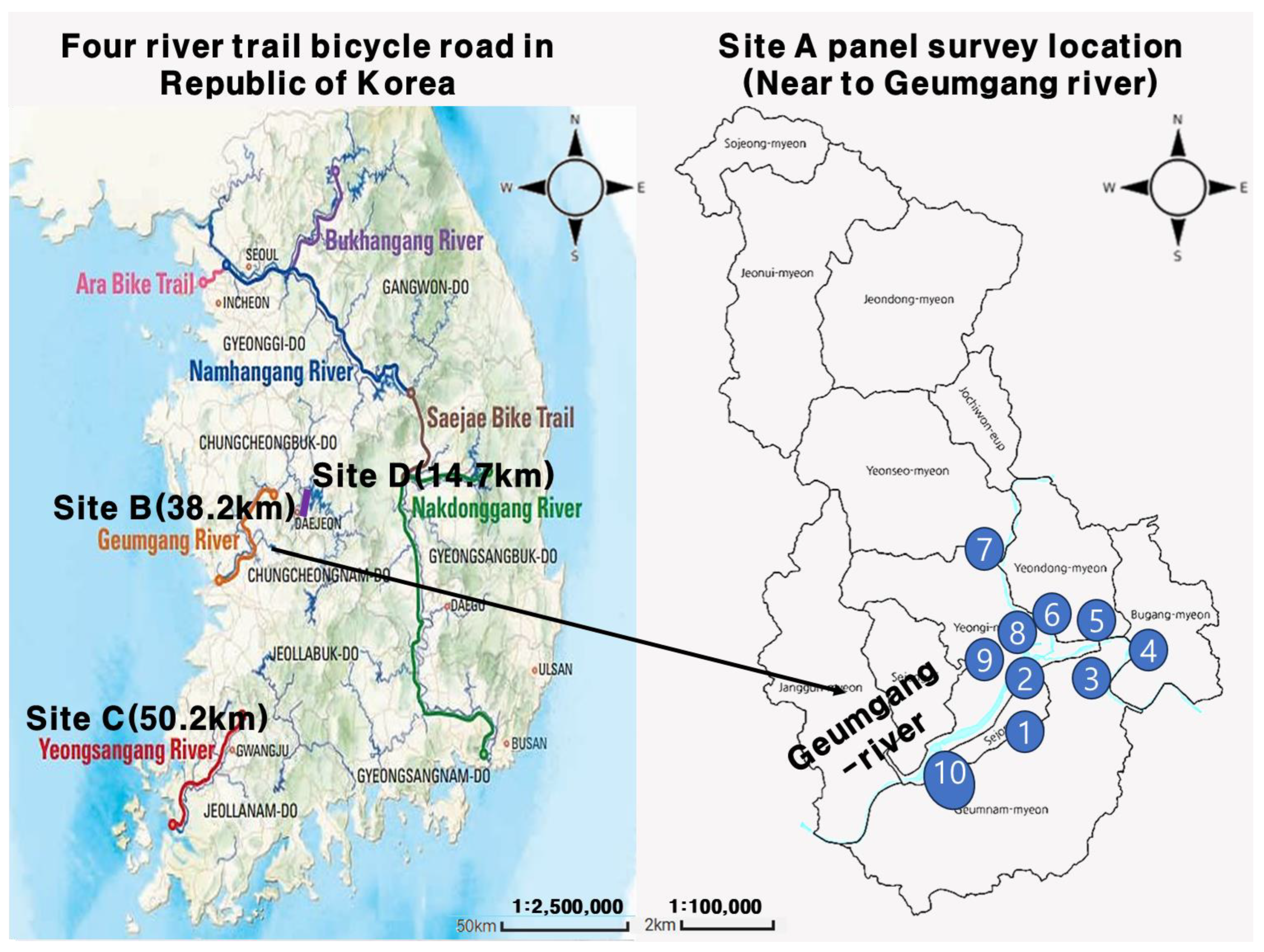
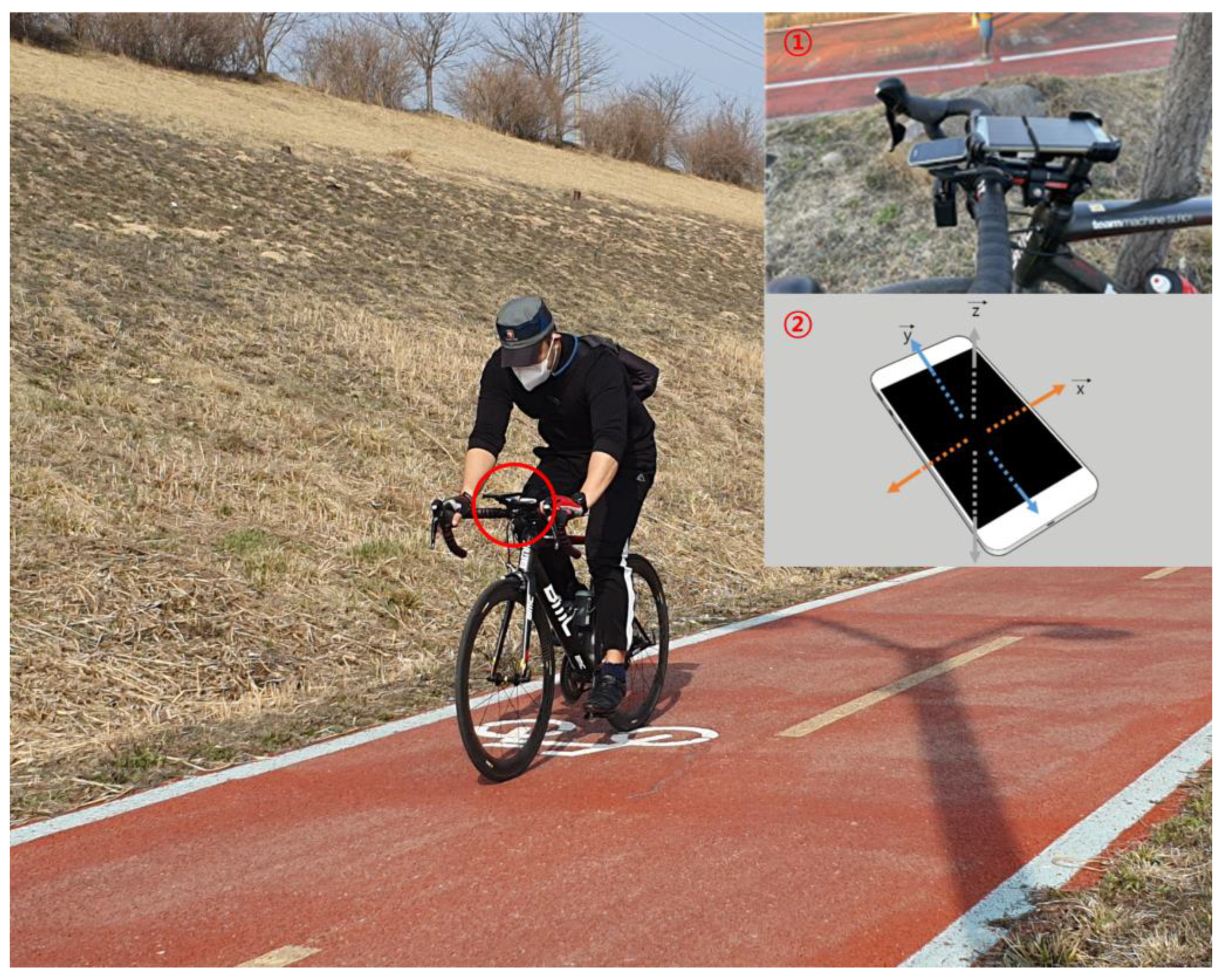
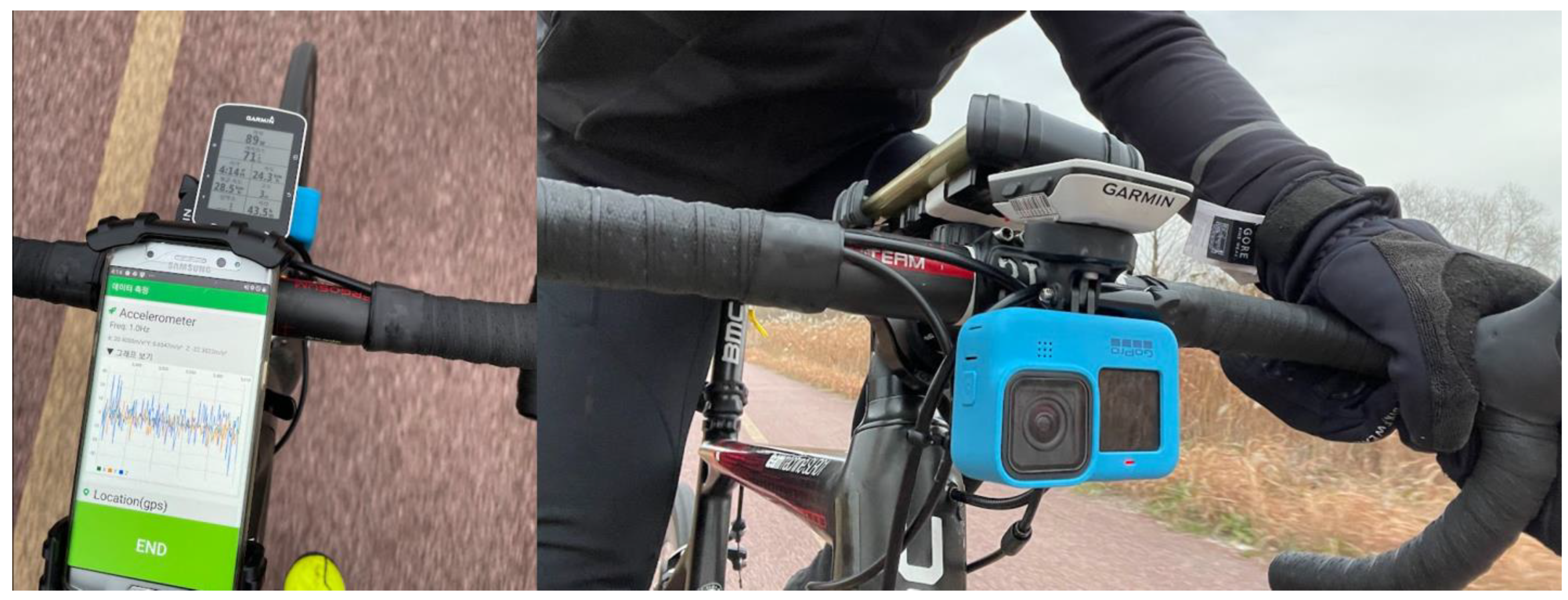
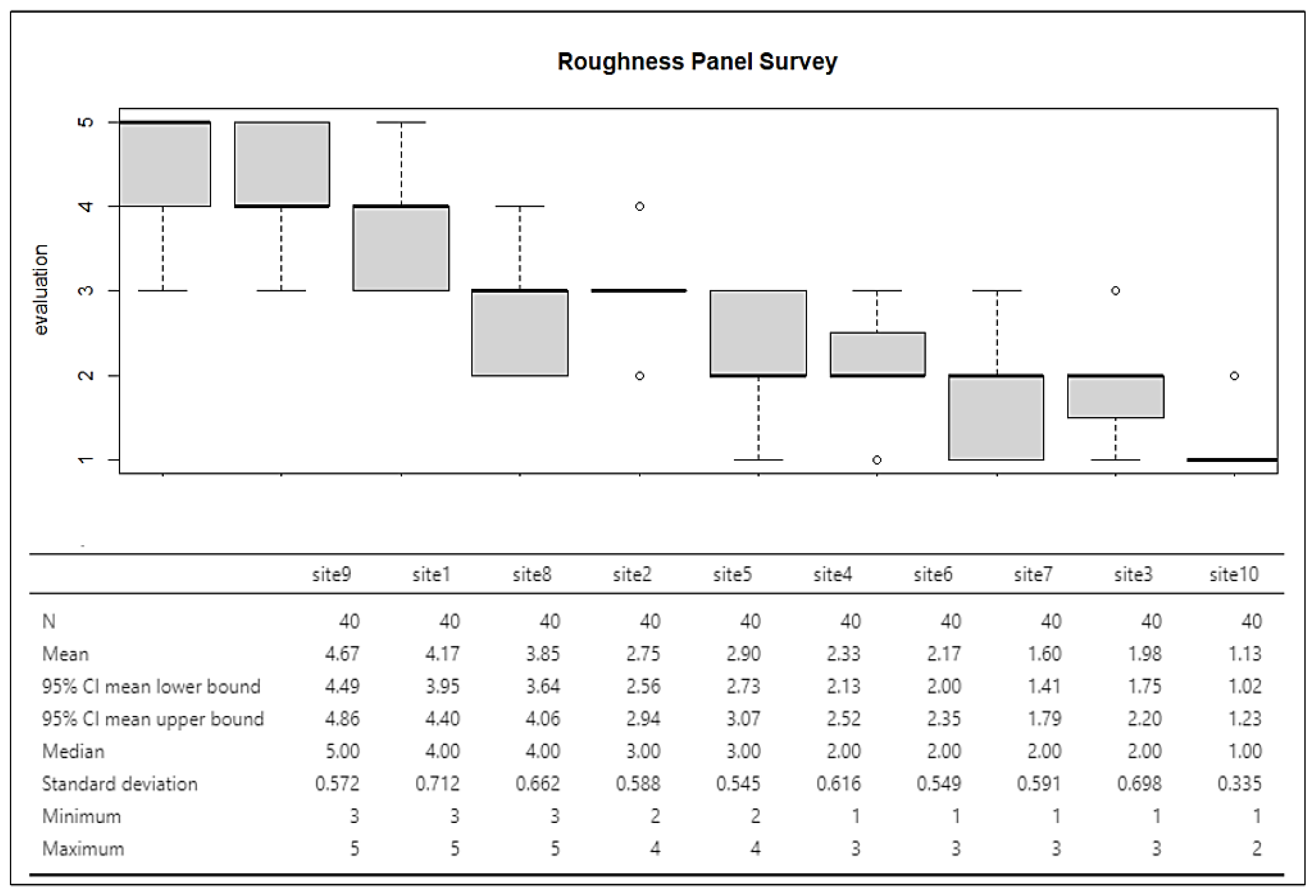
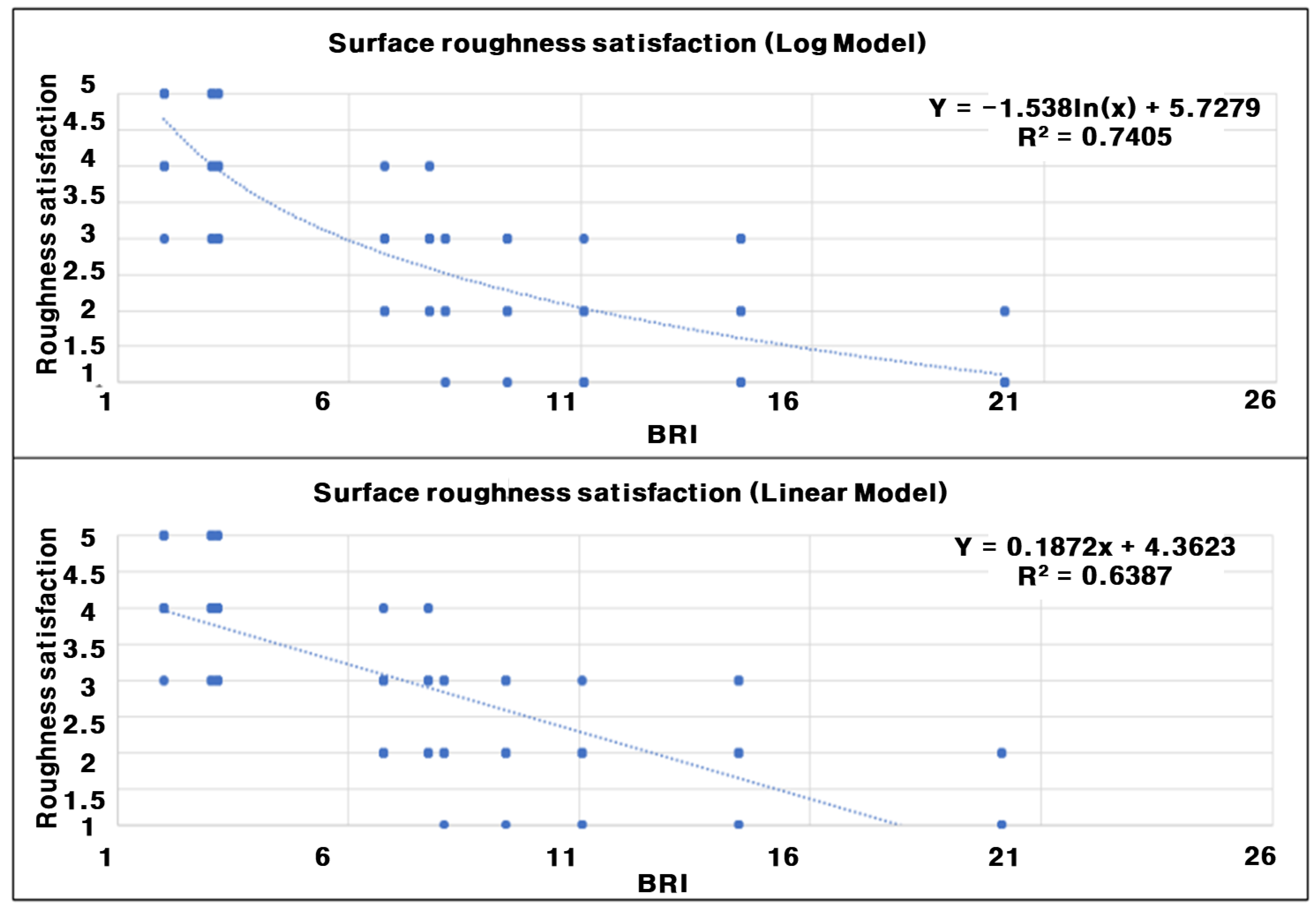
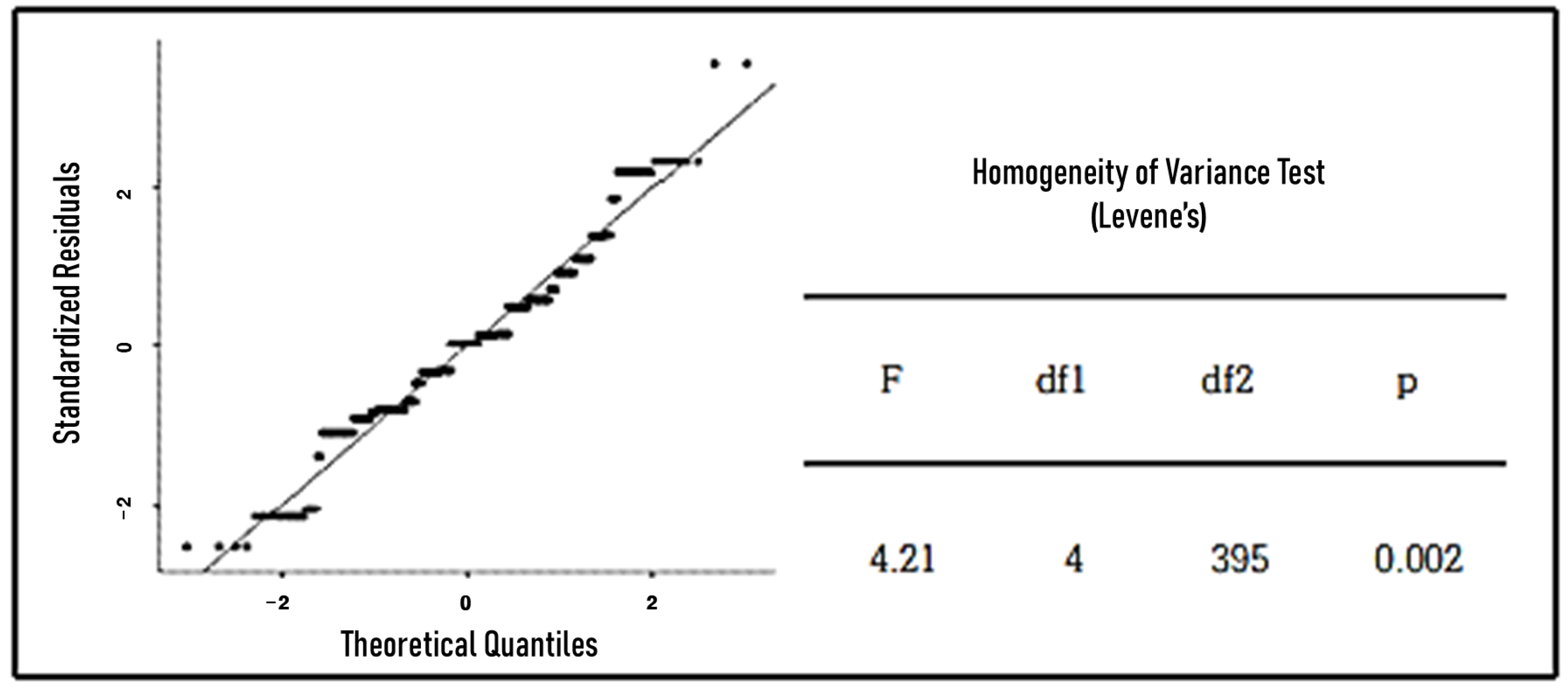

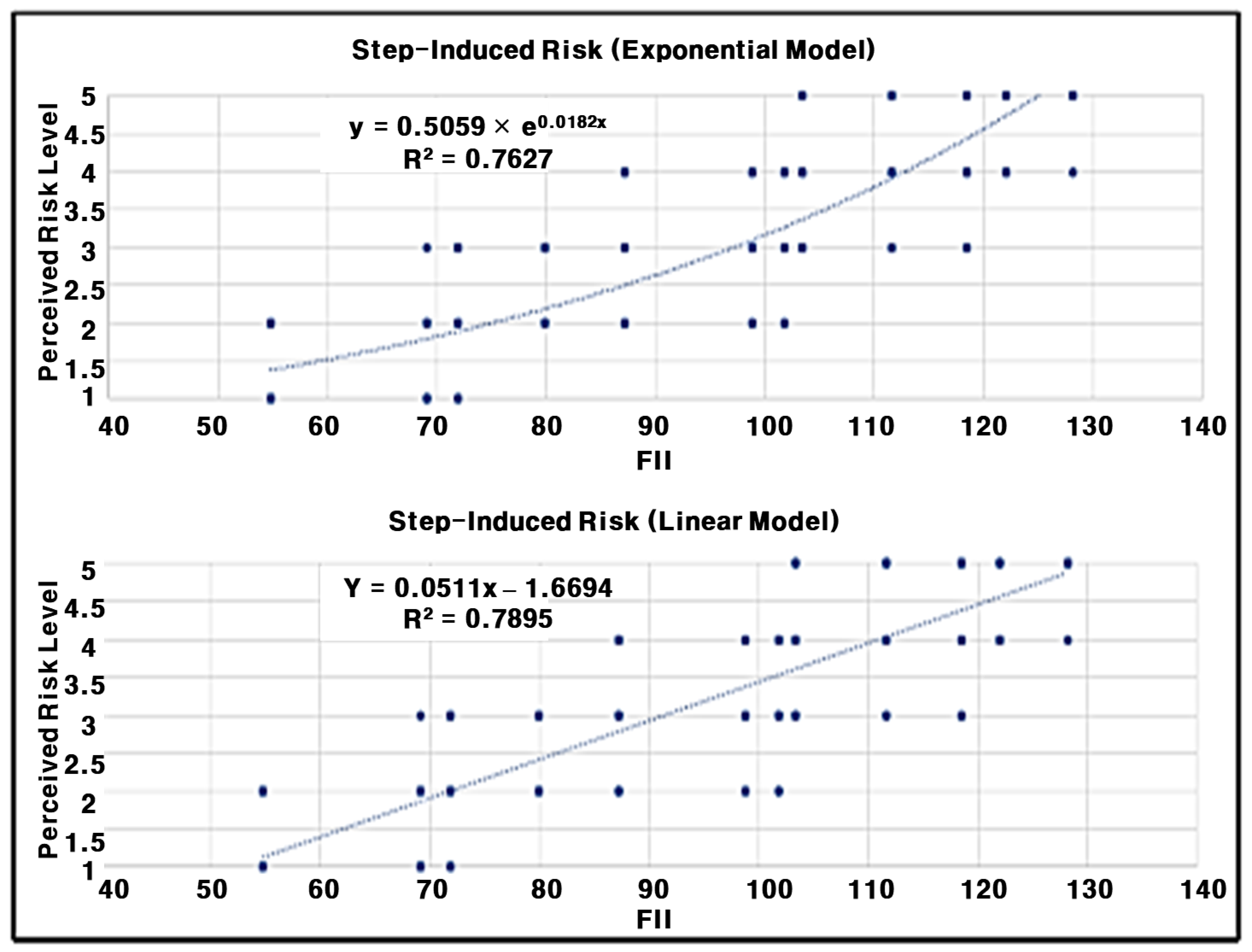
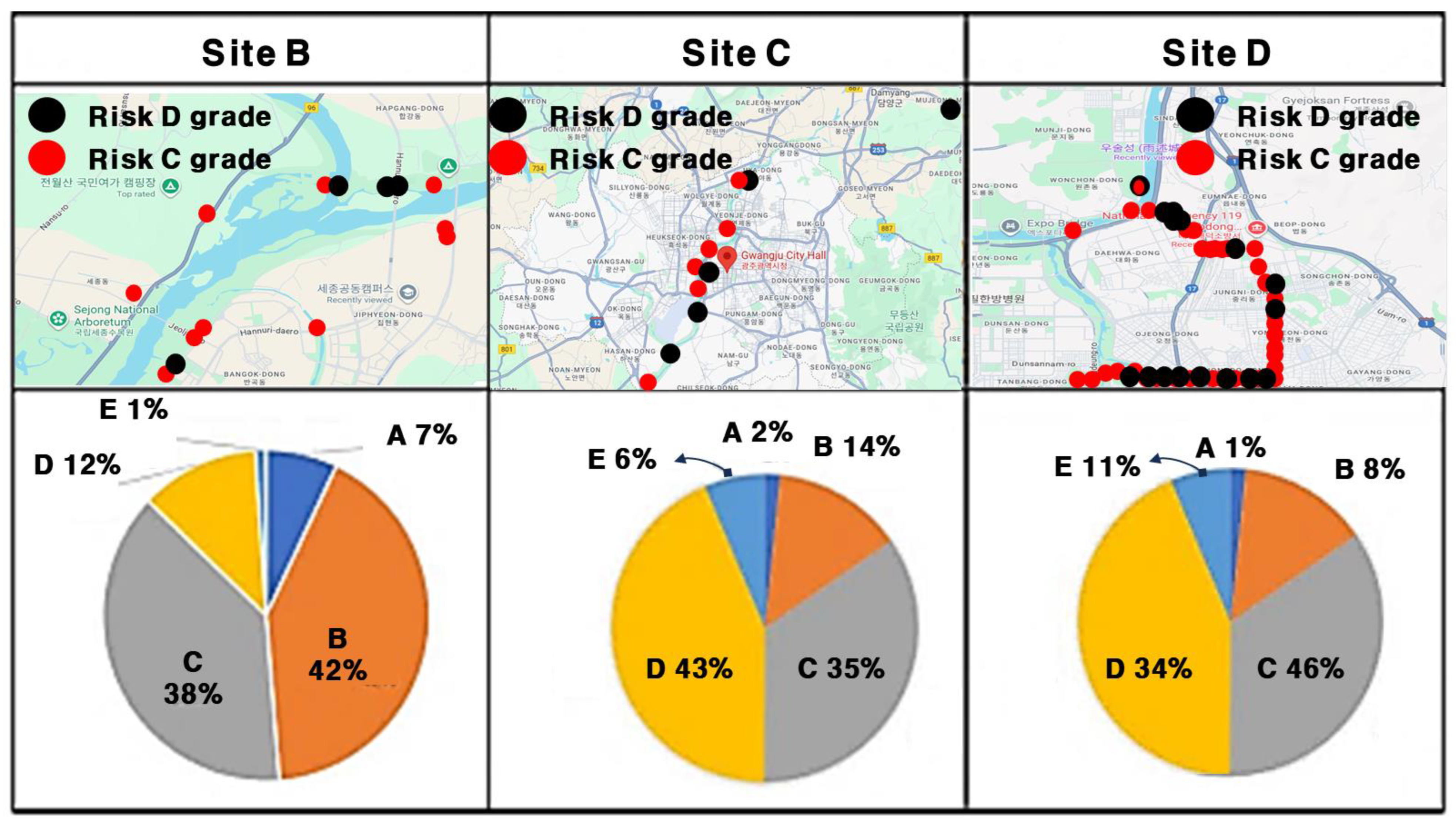

| Methods | Measurement Site | Pavement Type | Built Year | AADT (Vehicle) | Surface Damage | Location |
|---|---|---|---|---|---|---|
| Panel Survey | Site A-1 | AP | 2021 | 9554 | None | Sejong-si, Republic of Korea |
| Site A-2 | CP | 2011 | 14,704 | None | ||
| Site A-3 | CP | 2011 | 13,958 | Yes | ||
| Site A-4 | CP | 2011 | 13,525 | Yes | ||
| Site A-5 | CP | 2011 | 60,573 | Yes | ||
| Site A-6 | CP | 2011 | 48,203 | Yes | ||
| Site A-7 | CP | 2011 | 47,890 | Yes | ||
| Site A-8 | CP | 2011 | 74,603 | None | ||
| Site A-9 | AP | 2011 | 76,745 | None | ||
| Site A-10 | CP | 2011 | 3201 | Yes | ||
| Methods | Measurement Site | Pavement Type | Built Year | Reason to choose | ||
| Pilot test survey | Site B (38.2 km) | AP, CP | 2011 | An evaluation of the entire section of the Geumgang Bicycle Road in Sejong City, which has the characteristics of various bicycle roads and includes a panel survey. | ||
| Site C (14.7 km) | AP, CP | 1993 | It was installed in 1993 and partially repaired, but it can be reviewed whether it is an appropriate evaluation criterion for the evaluation of both bicycle pedestrians and the management of bicycle paths in the Gwangju City. | |||
| Site D (50.2 km) | AP, CP | 2012 | It is a bicycle road over 10 years old installed in the waterfront space and includes non-urban sections in Daejeon City, so that the management status of the section can be reviewed. | |||
| Risk Level | Panel Survey Description |
|---|---|
| Safe | Perceived as safe while riding on generally flat pavement with only minor surface irregularities. |
| Slightly unsafe | Minor shocks cause slight difficulty in maintaining speed, but riding remains stable and manageable. |
| Risky | Shocks and impacts interfere with handlebar control, making balance difficult though still rideable—even if the discontinuity is not immediately visible. |
| Very risky | Severe impacts significantly disrupt handlebar control, posing a high risk of falling—even when the fault is not visually detected. |
| Not rideable | Sudden loss of balance from strong impacts may damage the bicycle or make it too dangerous to proceed. |
| Category | Segment 1 | Segment 2 | Segment 3 | Segment 4 | Segment 5 | Segment 6 | Segment 7 | Segment 8 | Segment 9 | Segment 10 |
|---|---|---|---|---|---|---|---|---|---|---|
| BRI | 3.04 | 6.77 | 14.45 | 9.41 | 7.72 | 8.07 | 11.06 | 3.18 | 2.00 | 20.15 |
| Panel rating | 4.17 | 2.75 | 1.98 | 2.33 | 2.90 | 2.17 | 1.60 | 3.85 | 4.67 | 1.13 |
| Risk Grade | BRI Range | Roughness Description |
|---|---|---|
| A | ≤2.2 | Very Good—smooth pavement with no visible cracks or patching; excellent ride comfort |
| B | 2.2 < BRI ≤ 4.3 | Good—minor unevenness in sections, but overall high ride quality |
| C | 4.3 < BRI ≤ 8.2 | Fair—some discomfort but generally rideable at desired speeds |
| D | 8.2 < BRI ≤ 15.6 | Poor—surface impacts reduce comfort and make consistent riding difficult |
| E | >15.6 | Not rideable—severe degradation poses safety risks; major intervention required |
| Speed | 15 km/h | 20 km/h | 25 km/h | |||||||||
|---|---|---|---|---|---|---|---|---|---|---|---|---|
| Step Height | 10 | 20 | 30 | 40 | 10 | 20 | 30 | 40 | 10 | 20 | 30 | 40 |
| FII | 54.8 | 71.9 | 98.8 | 188.5 | 69.1 | 87.2 | 103.4 | 122.0 | 79.0 | 101.8 | 111.6 | 128.2 |
| Panel Risk Rating | 1.4 | 2.1 | 3.1 | 4.3 | 1.7 | 2.8 | 3.7 | 4.8 | 2.3 | 3.2 | 4.2 | 5.0 |
| Risk Grade | FII Range | Risk Description |
|---|---|---|
| A | ≤59.4 | Safe |
| B | 59.4 < FII ≤ 87.3 | Slightly unsafe |
| C | 87.3 < FII ≤ 105.7 | Risky |
| D | 105.7 < FII ≤ 119.4 | Very risky |
| E | >119.4 | Not rideable (Severely risky) |
| Risk Grade | Number of Sections in Site B | Risk Description |
|---|---|---|
| A | All remaining sections | Safe |
| B | 115 | Slightly unsafe |
| C | 28 | Risky |
| D | 6 | Very risky |
| E | 0 | Not rideable (Severely risky) |
| Risk grade D | Representative picture using video camera | Reason |
| Segment 1 | 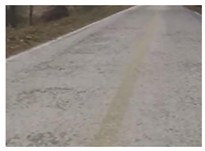 | Concrete raveling: disintegration of concrete where aggregates (small rocks and pebbles) are loosened and detach from the surface, leaving the concrete surface rough and potentially causing further deterioration. |
| Risk Grade | Number of Sections in Site C | Risk Description |
|---|---|---|
| A | All remaining sections | Safe |
| B | 63 | Slightly unsafe |
| C | 7 | Risky |
| D | 6 | Very risky |
| E | 0 | Not rideable (Severely risky) |
| Risk grade D | Representative picture using video camera | Reason |
| Segment 1 | 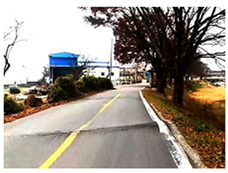 | Root-induced upheavals |
| Segment 2 | 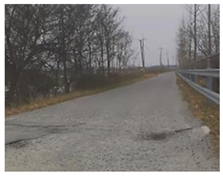 | Potholes |
| Segment 3 |  | Insufficient backfill near culverts |
| Segment 4 | 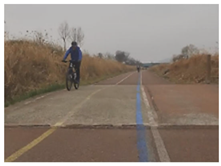 | Pavement rehabilitation section with step difference |
| Segment 5 | 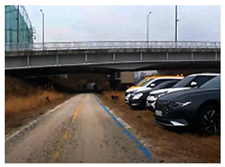 | Gravel accumulation |
| Risk Grade | Number of Sections in Site D | Risk Description |
|---|---|---|
| A | All remaining sections | Safe |
| B | 918 | Slightly unsafe |
| C | 342 | Risky |
| D | 39 | Very risky |
| E | 0 | Not rideable (Severely risky) |
| Risk grade D | Representative picture using video camera | Reason |
| Segment 1 |  | Entry and exit section |
| Segment 2 |  | Road raising due to root intrusion |
| Segment 3 | 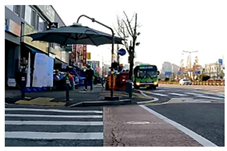 | Missing bicycle ramp |
| Segment 4 | 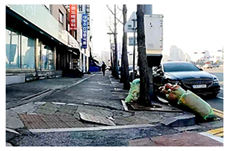 | Elevation differences caused by road facilities |
| Segment 5 | 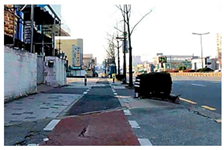 | Pothole |
| Risk Grade | BRI Range | Surface Condition |
|---|---|---|
| A | ≤2.2 | Very Good |
| B | 2.2 < BRI ≤ 4.3 | Good |
| C | 4.3 < BRI ≤ 8.2 | Fair |
| D | 8.2 < BRI ≤ 15.6 | Poor |
| E | >15.6 | Very poor |
| Risk Grade | FII Range | Risk Description |
| A | ≤59.4 | Safe |
| B | 59.4 < FII ≤ 87.3 | Slightly unsafe |
| C | 87.3 < FII ≤ 105.7 | Risky |
| D | 105.7 < FII ≤ 119.4 | Very risky |
| E | >119.4 | Not rideable (Severely risky) |
Disclaimer/Publisher’s Note: The statements, opinions and data contained in all publications are solely those of the individual author(s) and contributor(s) and not of MDPI and/or the editor(s). MDPI and/or the editor(s) disclaim responsibility for any injury to people or property resulting from any ideas, methods, instructions or products referred to in the content. |
© 2025 by the authors. Licensee MDPI, Basel, Switzerland. This article is an open access article distributed under the terms and conditions of the Creative Commons Attribution (CC BY) license (https://creativecommons.org/licenses/by/4.0/).
Share and Cite
Lee, D.; Yoo, H.; Lee, J.; Jeong, G. Smartphone-Based Assessment of Bicycle Pavement Conditions Using the Bicycle Road Roughness Index and Faulting Impact Index for Sustainable Urban Mobility. Sustainability 2025, 17, 7488. https://doi.org/10.3390/su17167488
Lee D, Yoo H, Lee J, Jeong G. Smartphone-Based Assessment of Bicycle Pavement Conditions Using the Bicycle Road Roughness Index and Faulting Impact Index for Sustainable Urban Mobility. Sustainability. 2025; 17(16):7488. https://doi.org/10.3390/su17167488
Chicago/Turabian StyleLee, Dongyoun, Hojun Yoo, Jaeyong Lee, and Gyeongok Jeong. 2025. "Smartphone-Based Assessment of Bicycle Pavement Conditions Using the Bicycle Road Roughness Index and Faulting Impact Index for Sustainable Urban Mobility" Sustainability 17, no. 16: 7488. https://doi.org/10.3390/su17167488
APA StyleLee, D., Yoo, H., Lee, J., & Jeong, G. (2025). Smartphone-Based Assessment of Bicycle Pavement Conditions Using the Bicycle Road Roughness Index and Faulting Impact Index for Sustainable Urban Mobility. Sustainability, 17(16), 7488. https://doi.org/10.3390/su17167488






